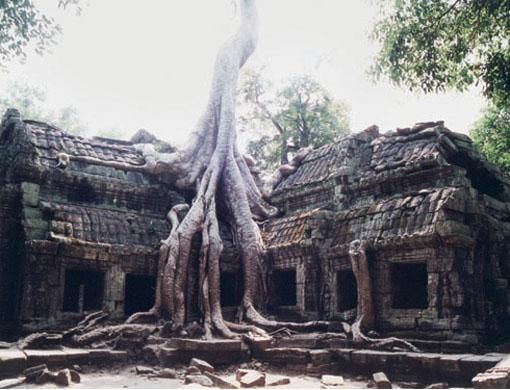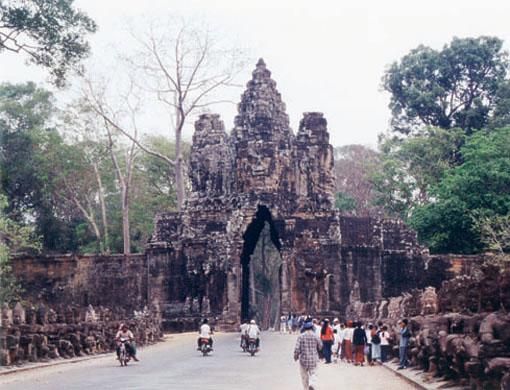For decades, Cambodia was in the news for all the wrong reasons.
Years of oppression, the Khmer Rouge regime, Pol Pot and massacres — all highlighted by the media — gave the country a bad name.
Adding to all the adverse publicity was the film The Killing Fields.
Naturally, tourists avoided the area. However, in the early Nineties, elections brought with them some semblance of normalcy.
Thus, after the many years of turbulence, travellers have begun to pour in, drawn by the urge to explore the wonders of the incredible ruins of the temples of Angkor Wat.
Mélange of cultures
Cambodia presents an interesting blend of traditions and ethnicity.
Around the 1st century, trade with India brought Hinduism and, later, Buddhism to its shores.
In AD 802, King Jayavarman's dynasty heralded the beginning of the Angkorian period, which was marked by the building of the magnificent temples.
Later, Thai, Vietnamese and French rule left their stamp. King Sihanouk came to power in 1953 and ruled until Khmer Rouge seized power.
Now, Cambodia is a constitutional monarchy where peace reigns.
Building of the temples
The temples of Angkor were built between the 9th and 14th centuries, when the Khmer empire was at its zenith, stretching across vast swathes in South East Asia.
Jayavarman II established himself as the “God king'' and embarked on his mission to build colossal temples — a practice that was continued by the king's successors.
With the decline of the empire, these temples were swallowed up by jungles and although a few travellers and monks recorded their findings as they ventured through the thick forest, the temples were soon forgotten.
In 1860, French explorer Henri Mouhot discovered the Angkor temple ruins and was astounded by their magnificence.
His discovery made international headlines. Soon after, the explorer published Voyage a Siam et dans le Cambodge, which brought the lost temple city into the limelight on a global scale.
The French, long associated with Cambodia because of their colonial rule, made it their mission to “rescue'' the splendid ruins from the jungle. One must admit that they did a decent job of it.
Siam Reap-Angkor
|
Siam Reap, the gateway to Angkor is about 7km from the airport and is well connected with neighbouring countries.
Once ensconced in your hotel — it would be preferable to book a room in one of the charming little French guesthouses on a waterway — spend some time getting your bearings.
Then, armed with your camera, head out on a sightseeing mission.
There are more than 100 ancient structures spread out in the 75-square-mile temple complex.
Don't let guidebooks — which talk about all that has been looted — get you down.
Rest assured that whatever remains (read could not be looted because they were too huge to carry away) will still succeed in astonishing you.
Some temples, such as Ta Prohm, have been wrapped and hidden by enormous roots, at times saving them from destruction, while others have a row of headless statues. It is said the heads were looted.
In 1992, Angkor Wat was declared a Unesco World Heritage Site, but that has not deterred the looters from plundering the artefacts.
Angkor Wat
The name means “City Temple'' and it is the largest and best preserved of the temples.
It was a temple, a shrine, a mausoleum, an observatory and much more.
Constructed in the 12th century by King Suryavarman, the complex is simply breathtaking.
Enclosed in a huge moat, the towers rise up to reach the sky, each wall is covered with bas-relief depicting Hindu mythology and legends.
The “Great City'', which covers about 10 square km, has five spectacular gates.
In front of each gate stand giant statues of gods and demons. Within the area there is much to see, including the Terrace of the Leper King and the Terrace of Elephants, the latter used as a reviewing stand for ceremonies and as a base for the king's grand audience hall.
Bayon, which is within the complex, is my personal favourite among the temples.
It is a maze of corridors, steep flight of stairs and the most compelling 200 coldly smiling colossal stone faces of Avalokiteshvara, lord of compassion.
Enigmatic smile
A visitor seems to be just surrounded by the enigmatic smiles and brooding stone faces which seem to be watching every move of the intruder in their midst.
They have been there for centuries and will remain thus, the smile almost mocking the mere mortal treading on the sacred stones. It is a compelling place which needs many repeat visits.
The temple of Ta Prohm is another must-see attraction. Its appeal lies in the fact that unlike other temples of Angkor, it has been left to the jungle.
It looks pretty much the way it was when first discovered by explorers.
This deliberate neglect has caused much controversy among conservationists but it gives us an indication of the power of the jungle.
Built around a Buddhist temple in the 12th century, Ta Prohm was once a thriving city of 80,000 and there are signs of the past glory.
There are towers, courtyards and corridors. Most of them are clogged with roots, plants and shrubs which, at times, seem to hold the stones in place.
There is a surreal feel to the area as sunlight. It is also a spot to have your photograph taken to record your visit.
— Nirmal Khanna is a UAE-based freelance writer
Go there ... Angkor Wat ... From the UAE
From Dubai
Phnom Penh is the closest airport to Angkor Wat.
Malaysia Airlines flies daily via Kuala Lumpur.
Fare from Dh3,410
Thai Airways flies daily via Bangkok.
Fare from Dh3,300
China Southern Airlines flies daily via Guangzhou.
Fare from 3,230
Cathay Pacific flies daily to via Hong Kong.
Fare from Dh2,760
— Information courtesy: The Holiday Lounge by Dnata. Ph: 04-3166160








